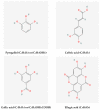Identifying the Anti-MERS-CoV and Anti-HcoV-229E Potential Drugs from the Ginkgo biloba Leaves Extract and Its Eco-Friendly Synthesis of Silver Nanoparticles
- PMID: 36771041
- PMCID: PMC9919260
- DOI: 10.3390/molecules28031375
Identifying the Anti-MERS-CoV and Anti-HcoV-229E Potential Drugs from the Ginkgo biloba Leaves Extract and Its Eco-Friendly Synthesis of Silver Nanoparticles
Abstract
The present study aimed to estimate the antiviral activities of Ginkgo biloba (GB) leaves extract and eco-friendly free silver nanoparticles (Ag NPs) against the MERS-CoV (Middle East respiratory syndrome-coronavirus) and HCoV-229E (human coronavirus 229E), as well as isolation and identification of phytochemicals from GB. Different solvents and high-performance liquid chromatography (HPLC) were used to extract and identify flavonoids and phenolic compounds from GB leaves. The green, silver nanoparticle synthesis was synthesized from GB leaves aqueous extract and investigated for their possible effects as anti-coronaviruses MERS-CoV and HCoV-229E using MTT assay protocol. To verify the synthesis of Ag NPs, several techniques were employed, including X-ray diffraction (XRD), scan, transmission electron microscopy, FT-IR, and UV-visible spectroscopy. The highest contents of flavonoids and phenolic compounds were recorded for acetone, methanol, and ethanol as mixtures with water, in addition to pure water. HPLC flavonoids were detected as apegenin, luteolin, myricetin, and catechin, while HPLC phenolic compounds were pyrogallol, caffeic acid, gallic acid, and ellagic acid. In addition, our results revealed that Ag NPs were produced through the shift from yellow to dark brown. TEM examination of Ag NPs revealed spherical nanoparticles with mean sizes ranging from 5.46 to 19.40 nm and an average particle diameter of 11.81 nm. A UV-visible spectrophotometric investigation revealed an absorption peak at λ max of 441.56 nm. MTT protocol signified the use of GB leaves extract as an anti-coronavirus to be best from Ag NPs because GB extract had moderate anti-MERS-CoV with SI = 8.94, while had promising anti-HCov-229E, with an SI of 21.71. On the other hand, Ag NPs had a mild anti-MERS-CoV with SI = 4.23, and a moderate anti-HCoV-229E, with an SI of 7.51.
Keywords: Ginkgo biloba; anti-coronavirus; natural products; silver nanoparticles.
Conflict of interest statement
The authors declare no conflict of interest.
Figures













Similar articles
-
In vitro virucidal activity of Echinaforce®, an Echinacea purpurea preparation, against coronaviruses, including common cold coronavirus 229E and SARS-CoV-2.Virol J. 2020 Sep 9;17(1):136. doi: 10.1186/s12985-020-01401-2. Virol J. 2020. PMID: 32907596 Free PMC article.
-
Green Synthesis of Narrow-Size Silver Nanoparticles Using Ginkgo biloba Leaves: Condition Optimization, Characterization, and Antibacterial and Cytotoxic Activities.Int J Mol Sci. 2024 Feb 5;25(3):1913. doi: 10.3390/ijms25031913. Int J Mol Sci. 2024. PMID: 38339192 Free PMC article.
-
Phytofabrication of Silver/Silver Chloride Nanoparticles Using Aqueous Leaf Extract of Oedera genistifolia: Characterization and Antibacterial Potential.Molecules. 2019 Nov 30;24(23):4382. doi: 10.3390/molecules24234382. Molecules. 2019. PMID: 31801244 Free PMC article.
-
Antibacterial efficacy of silver nanoparticles against multi-drug resistant clinical isolates from post-surgical wound infections.Microb Pathog. 2017 Jun;107:327-334. doi: 10.1016/j.micpath.2017.04.013. Epub 2017 Apr 11. Microb Pathog. 2017. PMID: 28411059
-
Green synthesis, characterization of silver nanoparticals for biomedical application and environmental remediation.J Microbiol Methods. 2022 Feb;193:106384. doi: 10.1016/j.mimet.2021.106384. Epub 2021 Nov 23. J Microbiol Methods. 2022. PMID: 34826520 Review.
Cited by
-
Ginkgo Biloba and Long COVID: In Vivo and In Vitro Models for the Evaluation of Nanotherapeutic Efficacy.Pharmaceutics. 2023 May 22;15(5):1562. doi: 10.3390/pharmaceutics15051562. Pharmaceutics. 2023. PMID: 37242804 Free PMC article. Review.
-
Image segmentation for pest detection of crop leaves by improvement of regional convolutional neural network.Sci Rep. 2024 Oct 15;14(1):24160. doi: 10.1038/s41598-024-75391-4. Sci Rep. 2024. PMID: 39406923 Free PMC article.
-
In vitro and in silico biopotentials of phytochemical compositions and antistaphylococcal and antipseudomonal activities of volatile compounds of Argania spinosa (L.) seed oil.Front Bioeng Biotechnol. 2024 Mar 13;12:1348344. doi: 10.3389/fbioe.2024.1348344. eCollection 2024. Front Bioeng Biotechnol. 2024. PMID: 38544980 Free PMC article.
-
Biosynthesis approach of zinc oxide nanoparticles for aqueous phosphorous removal: physicochemical properties and antibacterial activities.BMC Chem. 2023 Aug 16;17(1):99. doi: 10.1186/s13065-023-01012-2. BMC Chem. 2023. PMID: 37587477 Free PMC article.
-
Green biologically synthesized metal nanoparticles: biological applications, optimizations and future prospects.Future Sci OA. 2024 May 15;10(1):FSO935. doi: 10.2144/fsoa-2023-0196. eCollection 2024. Future Sci OA. 2024. PMID: 38817383 Free PMC article. Review.
References
-
- Noor-E-Tabassum U., Das R., Lami M.S., Chakraborty A.J., Mitra S., Tallei T.E., Idroes R., Mohamed A.A.-R., Hossain J., Dhama K., et al. Ginkgo biloba: A Treasure of Functional Phytochemicals with Multimedicinal Applications. Evid. Based Complement. Altern. Med. 2022 doi: 10.1155/2022/8288818. - DOI - PMC - PubMed
-
- Zha J., Dong C., Wang X., Zhang X., Xiao X., Yang X. Green synthesis and characterization of monodisperse gold nanoparticles using Ginkgo biloba leaf extract. Optik. 2017;144:511–521. doi: 10.1016/j.ijleo.2017.06.088. - DOI
-
- Nasrollahzadeh M., Sajadi S.M. Green synthesis of copper nanoparticles using Ginkgo biloba L. leaf extract and their catalytic activity for the Huisgen [3 + 2] cycloaddition of azides and alkynes at room temperature. J. Colloid Interface Sci. 2015;457:141–147. doi: 10.1016/j.jcis.2015.07.004. - DOI - PubMed
MeSH terms
Substances
Grants and funding
LinkOut - more resources
Full Text Sources

